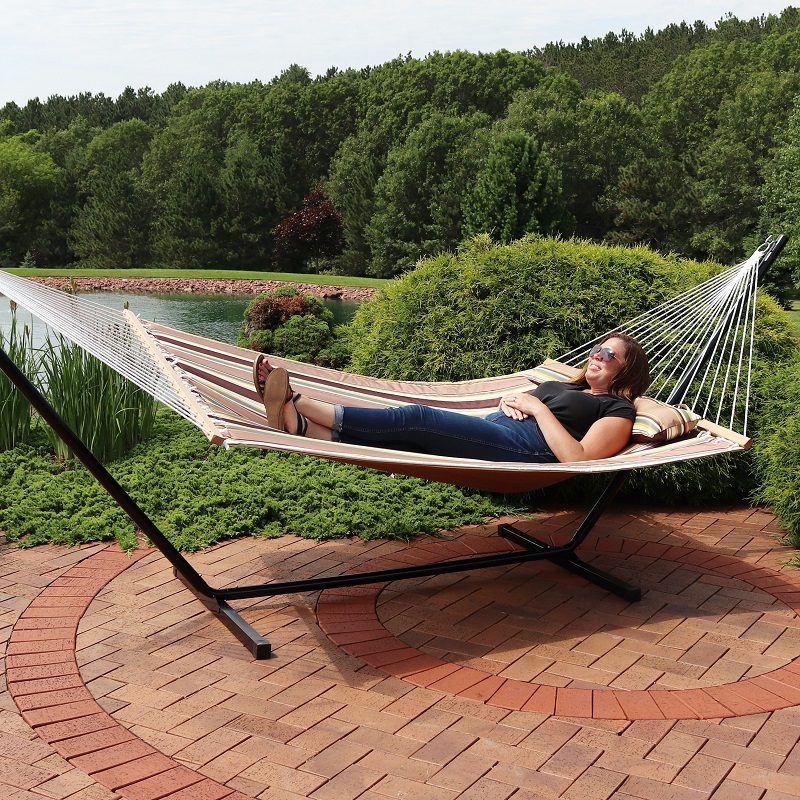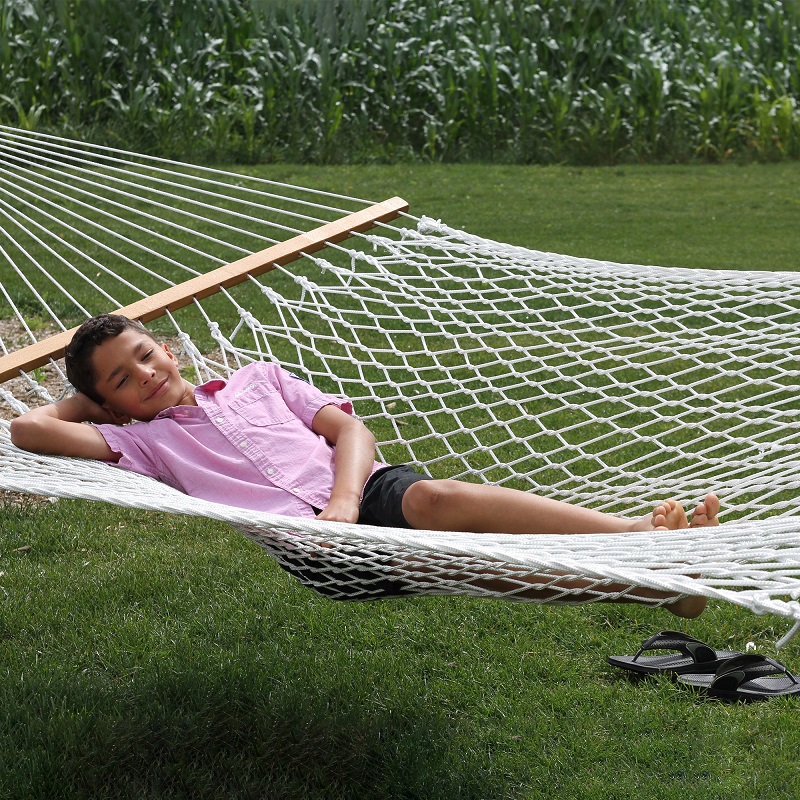The Essence of Hammocks: A Brief Overview
Historical Significance and Evolution
Hammocks have been a symbol of relaxation and leisure for centuries, with their origins traced back to the indigenous cultures of Central and South America. The word “hammock” comes from the Taíno word “hamaca,” reflecting its deep roots in indigenous traditions. Historically, these woven nets were used by various tribes for sleeping and resting, thanks to their ability to provide comfort and support. The design evolved over time, influenced by European colonists and the introduction of new materials and techniques. Today, hammocks are not just functional sleeping arrangements but also a staple of relaxation and outdoor living.
Modern Interpretations and Uses
In contemporary settings, hammocks have transcended their traditional uses and become popular in various forms, including portable versions and decorative pieces. Modern hammocks are made from a range of materials such as cotton, polyester, and nylon, each offering different benefits in terms of comfort, durability, and ease of maintenance. They are used not only in backyards and gardens but also in parks, beaches, and even indoor spaces, reflecting their versatility and the evolving understanding of relaxation and leisure.

The Psychological Impact of Hammocks: Relaxation and Stress Relief
The Science Behind Hammock Relaxation
The psychological benefits of hammocks extend beyond mere comfort; they are deeply connected to our mental and emotional well-being. The gentle swaying motion of a hammock has been shown to reduce stress and promote relaxation. This effect is partly due to the hammock’s ability to mimic the soothing sensations experienced in the womb, creating a sense of security and calm. Studies have indicated that this rhythmic movement can help lower cortisol levels, the hormone associated with stress, and promote a sense of tranquility.
The Role of Hammocks in Mindfulness and Meditation
Hammocks are also used as tools for mindfulness and meditation. The act of lying in a hammock encourages a state of stillness and allows individuals to focus on their breathing and thoughts without distraction. This environment can enhance mindfulness practices, making it easier to achieve a meditative state. The gentle sway of the hammock helps in centering the mind and promoting a deeper connection with the present moment, facilitating a more profound experience of relaxation and mental clarity.
Design Elements of Hammocks: Functionality and Aesthetics
Material Choices and Their Impact
The choice of material is crucial in hammock design, affecting both comfort and durability. Cotton hammocks are known for their softness and breathability, making them ideal for warm climates and extended lounging. Polyester and nylon, on the other hand, offer greater resistance to weather and wear, making them suitable for outdoor use in various conditions. Some modern hammocks combine materials, using cotton for comfort and synthetic fibers for strength and weather resistance. Each material has its own set of advantages and considerations, influencing the overall design and functionality of the hammock.
Shape and Structure: Traditional vs. Modern Designs
Hammocks come in various shapes and structures, each designed to enhance comfort and aesthetics. Traditional hammocks are often curved or banana-shaped, providing a natural and ergonomic fit for the body. Modern designs may incorporate different shapes such as spreader bar hammocks, which offer a flatter and more open surface. The choice between traditional and modern designs often depends on personal preference and the intended use of the hammock. Additionally, the design of the hammock can influence its portability, ease of setup, and overall visual appeal.

Choosing the Perfect Hammock: Factors to Consider
Purpose and Usage
When selecting a hammock, it is essential to consider its intended purpose. For backyard relaxation, a larger, more decorative hammock might be preferred, whereas a compact, portable hammock is ideal for camping or travel. The environment in which the hammock will be used also plays a significant role; outdoor hammocks should be weather-resistant, while indoor hammocks can be chosen based on aesthetic preferences and space constraints. Understanding the primary use will help in selecting the right design, material, and size for optimal comfort and functionality.
Installation and Maintenance
Proper installation and maintenance are crucial for ensuring the longevity and safety of a hammock. Installing a hammock involves selecting appropriate anchor points that can support the weight and ensure stability. This might include trees, posts, or specialized hammock stands. Regular maintenance includes cleaning the hammock according to the manufacturer’s instructions and inspecting it for any signs of wear or damage. Proper care will extend the life of the hammock and ensure continued comfort and safety during use.
The Cultural Significance of Hammocks: Traditions and Innovations
Hammocks in Different Cultures
Hammocks have played a significant role in various cultures, each adding its unique touch to the design and use of these versatile objects. In the Caribbean, hammocks are integral to both historical and contemporary life, symbolizing relaxation and leisure. In Southeast Asia, hammocks use in traditional practices and ceremonies, reflecting their cultural importance. Understanding these cultural variations provides a broader perspective on the hammock’s significance and the ways in which it has been adapted and embraced across different societies.
Contemporary Innovations and Trends
The evolution of hammock design continues with contemporary innovations that cater to modern lifestyles. Innovations include hammocks with built-in mosquito nets for camping, double hammocks for shared experiences, and modular designs that can be customized to fit various spaces. Trends also reflect a growing emphasis on eco-friendly materials and sustainable practices, aligning with the broader movement towards environmental consciousness. These innovations highlight the hammock’s adaptability and enduring appeal, demonstrating how traditional objects can evolve to meet contemporary needs.
The Benefits of Hammock Camping: Adventure and Comfort
Embracing the Outdoors with Hammock Camping
Hammock camping is gaining popularity among outdoor enthusiasts for its unique blend of comfort and adventure. Unlike traditional tents, hammocks provide a suspended sleeping arrangement that keeps campers off the ground, which can be especially beneficial in wet or uneven terrain. This elevation not only improves comfort but also offers a cooler and more breathable environment, which can be a welcome change during hot weather. Additionally, hammock camping reduces the impact on the environment, as it requires fewer disturbances to the ground and surrounding vegetation.
Essential Gear and Setup for Hammock Camping
When preparing for hammock camping, selecting the right gear is crucial for a successful experience. Essential items include a high-quality hammock, a sturdy suspension system, and a weather-appropriate tarp or rainfly. A good hammock will come with an integrated bug net for protection against insects and a comfortable sleeping pad or underquilt for insulation. Proper setup involves finding suitable trees or anchor points, ensuring they space correctly and can support the weight. Attention to detail in the setup process can make a significant difference in overall comfort and safety during the camping trip.

Conclusion: Embracing the Hammock Lifestyle
The Ultimate Relaxation Tool
In conclusion, hammocks represent more than just a place to rest; they embody the ultimate relaxation tool, offering a blend of comfort, psychological benefits, and aesthetic appeal. Whether used for outdoor leisure or indoor decoration, hammocks enhance our ability to unwind and connect with our surroundings. The evolution of hammock design and the integration of modern materials and technologies reflect a continued appreciation for this timeless object. Embracing the hammock lifestyle means incorporating relaxation and mindfulness into our daily routines, appreciating the balance between tradition and innovation.
Final Thoughts on Hammock Design and Use
Understanding the meaning and significance of hammocks provides insight into their role in our lives and their impact on relaxation and design. From their historical roots to contemporary innovations, hammocks continue to inspire and enrich our experiences. As we explore the various design elements and consider the factors for choosing the perfect hammock, we embrace not only a functional piece of outdoor furniture but also a symbol of comfort and tranquility.
